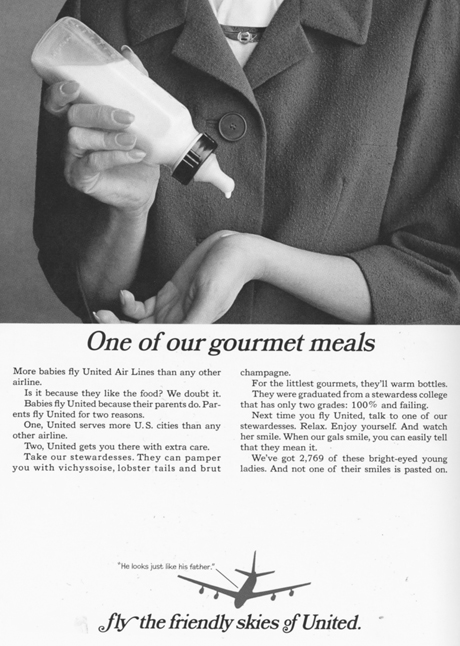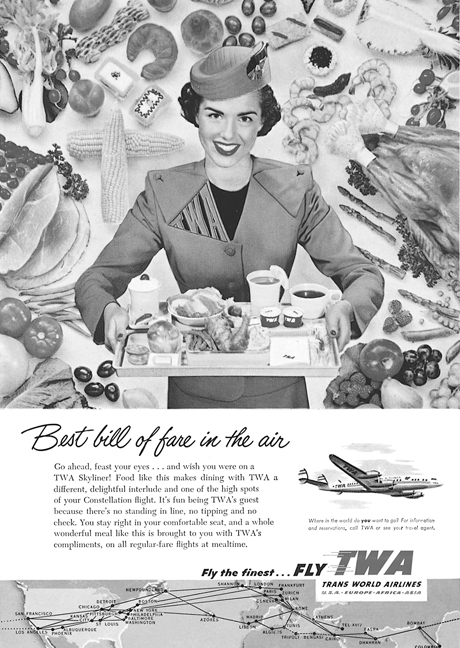|
Packaging a brand with a sellable message to hide its ethos sounds archaic. Back then in the 60's it was cutting edge. In this case the ad agency might have permanently altered UA's core value and persona unintentionally. Brand authenticity was seldom an agency's first priority unless it contributed to short term revenue boost. Sure, culture can change but it takes leadership's vision and time. Selling the friendly skies
BY VICTORIA VANTOCH, AB’97 | UNIVERSITY OF CHICAGO MAGAZINE —JULY–AUG/13 American stewardesses and the making of an iconic advertising campaign. ECONOMICS & BUSINESS | EXCERPT During the Mad Men era, virtually every heavy-hitting advertising agency was based in New York City. But hundreds of miles away, the boutique Leo Burnett Agency on East Randolph Street was proving itself a formidable competitor. In 1963, the Leo Burnett Agency was invited to bid for one of the nation’s most coveted ad accounts: United Airlines. Leo Burnett, the acclaimed ad- man behind the small Chicago agency, corralled his top creative team. They poured themselves into brainstorming sessions—analyzing United’s image, strategizing the pitch, and waxing philosophical about the future of air travel. Later that year, a cadre of United executives in pinstriped suits convened in a smoky boardroom to hear the admen’s pitch. The Burnett team laid it out: United was the General Motors of air travel—“professional, official-looking” and “a little stuffy and cold—coldly efficient, with a production-line attitude.” Then came the real blow: the ad team called United “stodgy” and “dull.” William Patterson, United’s president since its beginnings in 1934, prided himself on the airline’s hard-won reputation for reliability, but he knew that United desperately needed to sell more seats... - Full Article
0 Comments
Something I have been trying to emphasize with my partners and clients. However it's very hard to implement the change, not the technical nor the tactical part but the philosophy, strategic vision of the business and its core business model. Take McDonald for example, it did a great jobs in the recent years trying to portrait a healthier and greener image for itself. Unfortunately its core operation such as recipe and ingredients would not likely to change if the law is not broken or the negativity externality not exposed (We thank the whistle-blowers for keeping the pressure on). How can it be transparent and authentic if the message of being good is only a marketing pretext while the core strategy is still maximizing profits legally while not optimizing (health, as one of many) benefits for the customers? At the moment, it is much harder for a large corporation than a small startup to achieve genuine authenticity and transparency. Notice the new DC logo at theatre when watching Dark Knight Rises? It's one of many variations in a brand identity system that invoked lots of online passionate debates about whether it is better and working. Remember Gap?. The difference is, Gap had almost zero likes. DC's new logo got lots of good reviews among designers, comic fans, and “normal” folks.
For a love brand such as DC Comics, you know for sure any change will draw tons of resistances whether they are justified or not. People are just so attached to their own projections of what the brand is, guaranteed there would be no sure win (“sure lost” , again, like “Gap” is much easier to “achieve”:P). I personally like this design (creator being a client has nothing to do with it) a lot. Like most geeks, I grew up reading comic books. When I saw a few of the variations upon this system's release, I got all the super hero narratives right away. The visuals invokes deep story telling, unlike the previous flat, line art rendition. The new system is dimensional, dynamic, and works very well onscreen (from Iphone to Imax... (not part of Apple's ecosystem ;)). Some said the logo is corporate, I disagree. Not the versions with the illustrative treatment. The flat version can be, which is appropriate, it's owner by Warner Bros after all. Downers out there, do give it some time... it'll grow on you. I recall how negative some of our cohorts felt when they first learned about the change of our B-School's name from Chicago GSB to Chicago Booth. Some even created an online group to boycott against the evolution. Few years after none of us refer ourselves as GSB alumni anymore. Recently several clients requested me to create brand assets with a specific yet similar visual style. I started asking myself when was the last time that happened? Was that coincidence or a reflection of a bigger trend? In fact I can recall several significant visual fads in the past couple decades. They were indeed the results of certain technological or market disruptions (or bubbles). I do have a few subjective observations, they are of course by no mean the outcome of any empirical research.
Bubbly 90's: During the dot com bubble when the optimism was high, businesses competed to demonstrate their creative capacity as assets. All fundamental financial ratios were irrelevant as long as your business has something to do with web. The bubble has furnished us with numerous projects requesting us to create assets that are gestural, creative, whitty and whimsical. Everyone was in a good mood. We all know what happened when the bubble was burst. Photoshopper: When Adobe Photoshop became such a hot app that threatened the livelihood of many professional photographs, designers and illustrators were also pressured to create assets that shamelessly revealed off the different special and layer effects of the software. In my opinion, the design field has entered a dark age that resembled the naissance of desktop publishing. When visual communication served a better purpose promoting the tools than communicating a message, regardless how brilliant the tools are. Recession realist: Recession hit US right after W took over the white house. Layoffs, budget cuts, for sure less experimentations on marketing communication. The consumers were spending mostly on the essentials. Big companies were playing it safe, even with brand building. We were assigned many projects using more realistic visual styles, depicting products instead of concepts. Technical line art: I had no idea where this came from, The line drawing used mainly in instructional inserts or back panels (which we also do a lot) became mainstream. They took on a more heroic role in communication in packaging, collaterals, and info-graphical materials. Interestingly, this style seems straight forward at first glance, but indeed requires a quite strategic mind. Designers who create artworks has to make smart decision on what to show and what not. Importance of elements represented only by differentiating line weight or some minimal uses of colors. Revival of fun (or bubble?): They called it the second coming of tech bubble in the silicon valley.Companies such as Groupon, Facebook...etc, with unjustifiable earning ratios and valuation do well in their IPOs. With VCs hedging their bets investing in multiple startups ran by young leaders who were born shortly before the first bubble, we see a lot of parallels between the two markets. We are getting requests for doing fun concepts again. More metaphorical story telling, more gestural and fun visual styles, simplistic, humorous, gestural...and less direct depiction of products and services. The increasing demand for creative execution reminds me the best time in 90's, yet it also reminds me the lost of paper wealth that many of my peers suffered. Stock options that once worth millions became liability if realized. Some of us didn't get hit as badly due to a high percentage of assets invested in Real Estate, which did quite well for the following decade. Equity grew at double digits for years... until of course the recent crash of market in 2007. Worst of it all, is that we've not yet seen the bottom of the real estate bubble yet. After recent Facebook's IPO, many newly minted millionaires have entered the housing market looking for homes. Maybe this second coming of tech bubble will help lift the market, and bail out some of those Real Estate investors who are still drowning under water now. Wishful thinking, I know. |
Filip Yip:A designer, illustrator, repro-media consultant, brand strategist, new product developer, real estate investor, new venture builder, scuba diver, martial artist… and most importantly, husband and father, Filip holds a BFA from The Academy of Art University in San Francisco, and an MBA from The University of Chicago Booth School of Business. He is constantly seeking equilibrium between Form and Function; Purpose and Survival; He is equally comfortable with fuzzy feeling and fussy Archives
April 2024
Categories
All
|


